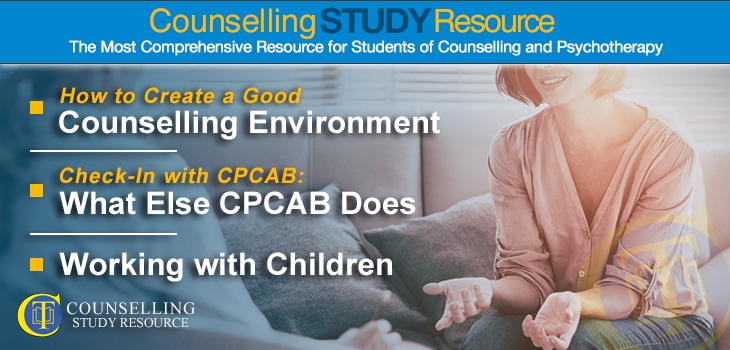142 – How to Create a Good Counselling Environment
What Else CPCAB Does – Working with Children
In episode 142 of the Counselling Tutor Podcast, Ken Kelly and Rory Lees-Oakes look at how to create a good counselling environment – talking about the ideal elements and the bare minimum. ‘Check-In with CPCAB’ then describes CPCAB’s other activities that you might not already be aware of. Finally, in ‘Practice Matters’, Rory interviews a specialist in working with children.
* BACPAC practice management software for counsellors and psychotherapists is a sponsor of the Counselling Tutor Podcast.
Get a 30-day free trial of BACPAC and a 30% discount by using the discount code CT2020
How to Create a Good Counselling Environment (starts at 1.50 mins)
This question on creating a good counselling environment was raised in the Counselling Tutor Facebook group.
If you’re not already a member, do come along and join in our discussions of current topics in the world of counselling and psychotherapy with thousands of counselling students, qualified counsellors, supervisors and counselling tutors.
Ken and Rory first talk about the ideal counselling environment, which should:
- be accessible (e.g. for wheelchair users) – of, if this is impossible to achieve, advance warning and the offer of onward referral be given
- meet health and safety requirements, including clients being made aware of the fire alarm and protocols
- have appropriate decoration, furnished professionally and comfortably, including no faith symbols and no family photos
- meet any individual client needs (e.g. a client with body dysmorphia may not want any mirrors in the room, or a client may be triggered emotionally by a specific colour)
- have a silent clock that is visible to both parties.
In reality, all these elements may not be present, as Ken found in his own placement experience.
The minimal requirements for a counselling room are that it facilitates confidentiality in terms of both:
- sound (preventing anyone outside the room or in an adjacent room overhearing)
- vision (so that any passers-by cannot see the client sitting there, for example through an external window or a glass pane in the door)
Following discussion with his supervisor, Ken took along his own ‘props’ to help make the room feel like a good space for counselling.
Rory has written a handout on how to create a good counselling environment. This is available here, or through the Handouts Vault and Counselling Study Resource (CSR).
Check-In with CPCAB: What Else CPCAB Does (starts at 15.45 mins)
Many people are aware of CPCAB (Counselling & Psychotherapy Central Awarding Body) as – in line with its name – an exam board that organises and issues qualifications in our field. In fact, CPCAB does far more than this.
Rory talks to Ray van der Poel (Head of Business and Development) about CPCAB’s initiative entitled ‘New Vision for Mental Health’.
Based on the Power Threat Meaning Framework developed by psychologist Lucy Johnstone and colleagues, this seeks to shift how mental health is viewed and approached from the traditional biomedical model to a social model – moving away from asking about symptoms and diagnosing a condition towards listening to and understanding the person’s story, lived experience and natural responses.
You can find more information about CPCAB on its website. CPCAB is the UK’s only awarding body run by counsellors for counsellors.
Working with Children (starts at 29.50 mins)
Psychotherapist and doctoral researcher Catherine Knibbs is a specialist in working therapeutically with children.
In this segment of the Counselling Tutor Podcast – aimed at qualified practitioners – Rory talks to Catherine about the differences between working with children and working with adults.
Key themes that arise during this conversation are:
- taking a holistic approach
- serving as an advocate as well as counsellor for the child
- working phenomenologically (i.e. hearing the world view of the child)
- psycho-educating key adults in the child’s life on what the child needs and how to provide an environment that best supports this.
In a brand-new section of the CSR especially designed for qualified counsellors, you’ll find a lecture by Catherine on working with children in therapy, including a downloadable slide pack.
Practice Matters is sponsored by Bacpac, a client-management software for counsellors and psychotherapists.
Bacpac offers all Counselling Tutor Podcast listeners a 30% discount, which you can claim by visiting the Bacpac website and using the code CT2020.
Free Handout Download
The Right Environment for Counselling
